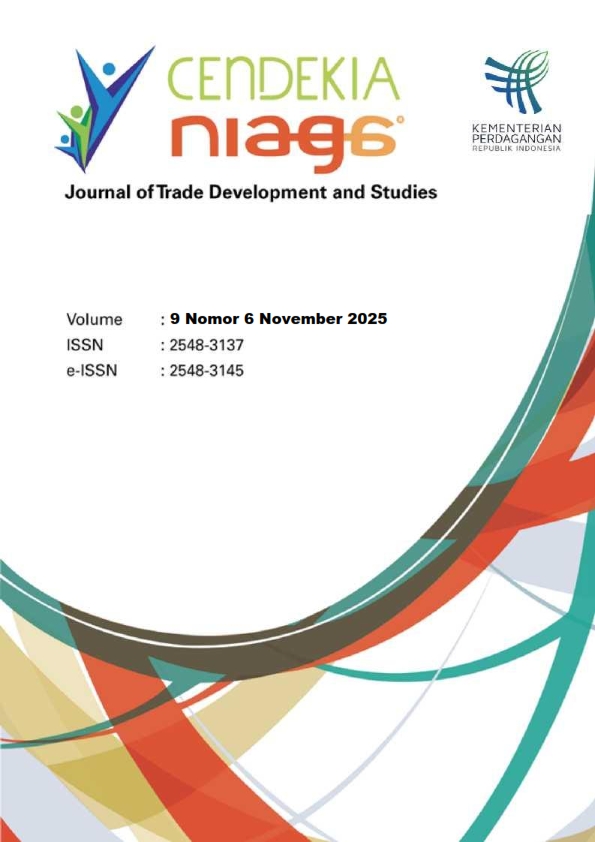Faktor-faktor yang Berkontribusi terhadap Kepemilikan Sertifikasi Usaha di Kalangan Peserta Pelatihan UMKM di Jawa Timur
Main Article Content
Abstract
This study aims to analyze the influence of the education of business owner, type of business, business turnover, and number of employees on the ownership of a Business Identification Number (NIB) in Micro, Small, and Medium Enterprises (MSMEs) of East Java Province. Data gathered from 1,041 MSMEs and the binary logistik regression method, that found simultaneously the variabels of education, type of business, and turnover had a significant effect on NIB ownership, while the number of employees was not significant either simultaneously or per category. Specifically, education had a collective effect but there was no particular level of education that individually significantly increased the chances of having a NIB. The type of business was the most consistent factor: MSMEs in the handicraft, fashion, and food/beverage sectors had a significantly higher chance of having a NIB than other sectors. Turnover had a significant effect simultaneously, but no particular turnover category was found to individually increase the chances of having a NIB. The number of employees did not show a significant effect on NIB ownership, either simultaneously or in each category. This finding confirms that the strategy of increasing business legality through NIB in MSMEs is more effective if it is focused on education and mentoring of potential business sectors, not solely based on turnover or number of employees. This study provides policy implications so that government intervention is more directed at strengthening access to information, legal assistance, and business sectors that empirically need more formal legality.
Article Details

This work is licensed under a Creative Commons Attribution-ShareAlike 4.0 International License.
References
Abor, J. Dan Quartey, P. (2010). Isu-Isu Dalam Pengembangan Ukm Di Ghana Dan Afrika Selatan. . Jurnal Riset Internasional Keuangan Dan Ekonomi,, 218-228.
Acemoglu & Autor. (2011). Tasks And Technologies: Implications For Employment And Earnings. In Handbook Of Labor Economics (Hal. 1043-1171). Amsterdam: Elsevier-North.
Anni Safitri, Ade Shofa Novrina, Siska Dewi. (2022). Faktor-Faktor Yang Mempengaruhi Persepsi Pelaku Umkm Terhadap Laporan Keuangan . Jurnal Aktual Akuntansi Keuangan Bisnis Terapan/Vol. 5, No 1, .
Arinaitwe, J. K. (2006). Factors Constraining The Growth And Survival Of Small Scale Businesses, A Developing Countries Analysis. Journal Of American Academy Of Business, 167-178.
Ashenafi Biru, P. A. (2024). Firm Formalization Strategy: The Interaction Of Entrepreneurs And Government Officials In The Enforcement Of Regulation. Journal Of Management.
Aulia, R. (2019, December 19). Analisis Regresi Logistik Biner. Diambil Kembali Dari Https://Www.Globalstatistik.Com/Analisis-Regresi-Logistik-Biner: diakses tanggal 23 Mei 2025, pukul 11.30
Barney, J. (1991). Firm Resources And Sustained Competitive Advantage. Journal Of Management, 99–120.
Becker, G. S. (1993). Human Capital: A Theoretical And Empirical Analysis, With Special Reference To Education (3rd Ed.). . Chicago: University Of Chicago Press.
Creswell. (2023). Research Design : Qualitative, Quantitative, And Mixed Methods Approaches. California: Thousand Oaks.
Dimaggio, P.J. Dan Powell, W.W. ((1983)). The Iron Cage Revisited: Institutional Isomorphism And Collective Rationality In Organizational Fields. American Sociological Review, 147-160.
Fatoki, O. Dan Asah, F. (2011). The Impact Of Firm And Entrepreneurial Characteristics On Access To Debt Finance By Smes In King Williams’ Town, South Africa. International Journal Of Business And Management, 6, 170-179.
Greiner, L. (1972). Evolution And Revolution As Organizations Grow. Harvard Business Review, 37-46.
Hair, J. F., Black, W. C., Babin, B. J., & Anderson, R. E. (2019). Multivariate Data Analysis (8th Ed.). Hampshire: Cengage Learning.
Hesti,I. Dan Ceacilia. (2022). Pengaruh Tingkat Pendidikan, Skala Usaha Dan Pengalaman Usaha Terhadap Penggunaan Informasi Akuntansi. Jurnal Akuntansi Profesi.
Hosmer, D. W., Lemeshow, S., & Sturdivant, R. X. . (2013). Applied Logistik Regression (3rd Ed.). . Wiley.
Maya Ruhtiani, Yuris Tri Naili, Faizal Rizky Yuttama. (2024). Sosialisasi Legalitas Badan Usaha Dan Pendaftaran Merek Dagang Dalam. Kreatif: Jurnal Pengabdian Masyarakat Nusantara , 225-240 .
Njinyah S., A. S. (2023). The Interaction Effect Of Government Non-Financial Support And Firm's Regulatory Compliance On Firm Innovativeness In Sub-Saharan Africa. European Journal Of Innovation Management Vol.26, 45-46.
Penrose, E. (1959). The Theory Of The Growth Of The Firm. . Oxford University Press.
Priscilla E And Michail. (1996). A Guide To Chi-Squared Testing. New York: John Wiley & Sons.
Rahmat, A. (2024). Pengaruh Modal, Tingkat Pendidikan Dan Teknologi Terhadap Pendapatan Umkm Kota Banda Aceh. Fakultas Ekonomi Dan Bisnis Islam Uin Arraniry.
Ranyane, K. A. (2015). Survivalist Entrepreneurship:An Income Generating Alternative For The Unemployed Populace . Mediterranean Journal Of Social Sciences Vol 6 No 4.
Shane, S., & Venkataraman. (2000). The Promise Of Entrepreneurship As A Field Of Research. Academy Of Management Review, 217-226.
Sidabalok, S. M. (2025). Pendampingan Pengurusan Nomor Induk Berusaha (Nib) Bagi Pelaku Umkm Di Kecamatan Bukit Raya Pekanbaru. Jurnal Pengabdian Masyarakat Akademisi, 124–132.
Storey, D. (1994). Understanding The Small Business Sector (1st Ed.). Routledge.
Welter, F. (2011). Contextualizing Entrepreneurship-Conceptual Challenges And Ways Forward. . Entrepreneurship Theory And Practice, 165-184.
Williem, J., Et Al. (2022). Pengaruh Modal Kerja, Omzet Penjualan, Dan Jam Kerja Operasional Terhadap Laba Pada Umkm Usaha Rumah Makan Mitra Gofood Di Kabupaten Sukoharjo. Universitas Surakarta.
